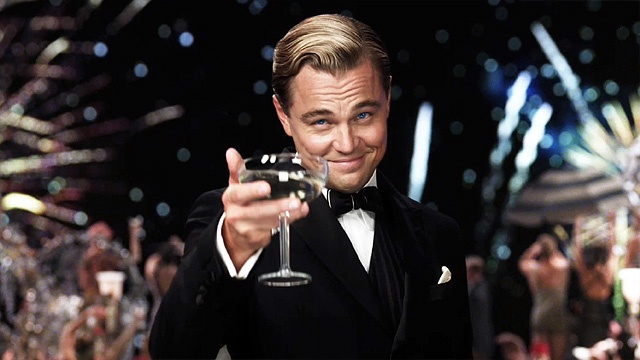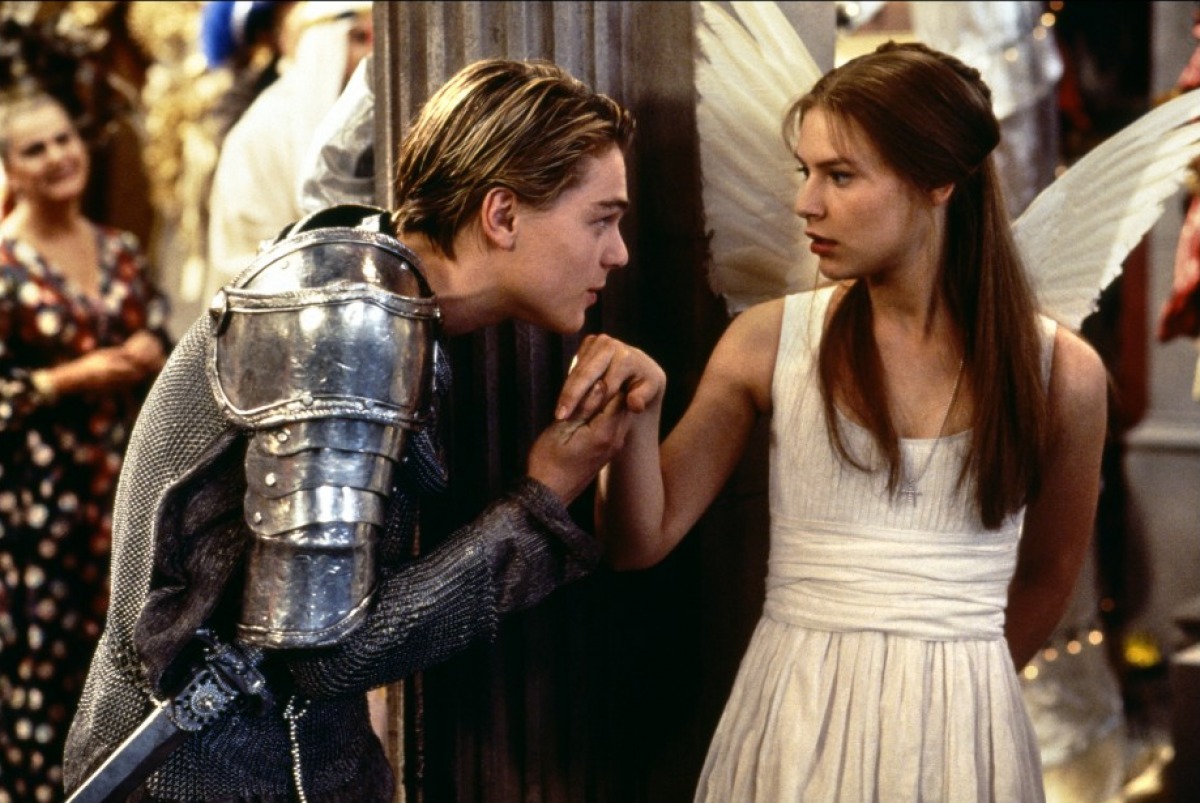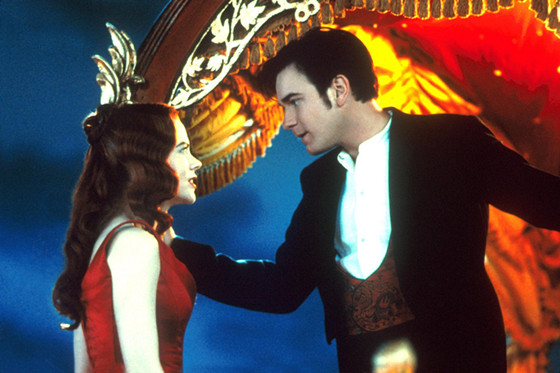3. The Great Gatsby (2013)

“Rich girls don’t marry poor boys.”
Luhrmann’s 5th film is an adaptation of F. Scott Fitzgerald’s paradigmatic “great American novel,” set during the roaring twenties. After Nick Caraway (Tobey Maguire) moves to West Egg, Long Island, he becomes enchanted with mysterious millionaire Jay Gatsby (Leonardo DiCaprio) and his ostentatious parties. Soon, he learns of Gatsby’s infatuation with Nick’s married cousin, Daisy Buchanan (Carey Mulligan), who lives across the bay in East Egg.
In an incredibly loyal realisation of Fitzgerald’s literary fiction, weaving in Caraway’s crucial narration, the film fully evokes the wider significance of the novel and the debaucherous fun of the jazz age. This is ingeniously impressed through jaw-dropping art deco sets, garish flapper costumes, a ticker tape of euphoric fast cuts and occasional use of silent movie fast motion. Even the smallest details of the book are brought to life to imbue the rich symbolism Fitzgerald intended, typified by the green dock light.
The Great Gatsby is clearly the book Luhrmann was born to adapt. He again engenders his signature themes, in what is his most profound, important script. This time, these are embodied in the form of old money versus new money, true love versus class constrictions. “The twenties were the beginning of the modern era,” related Luhrmann. “We are still in the modern era. That’s why that book speaks to us now.”
All the players are ingeniously cast, from Joel Edgerton’s bullish rendition of Tom Buchanan, to Luhrmann’s nod to Indian cinema, by casting Bollywood giant Amitabh Bachan as the sinister Wolfsheim. The reliably astonishing Leonardo DiCaprio delivers one of the most prodigious performances of his illustrious career, utilising his entire acting paintbox, with Gatsby’s legend mirroring his own. The film is a character study of Gatsby and DiCaprio fascinatingly balances him with equal measures of melancholy, hope, nefariousness, sensitivity, garishness, complexity and innocence. Also in one of her best roles, Mulligan attains Daisy’s effervescent, enrapturing quality, essential to inspire love in Gatsby and focalise the entire narrative. This is not to mention a brief cameo from Luhrmann himself as a waiter.
What lets down this nearly perfect film is the choice of soundtrack. The inclusion of hip hop and pop music unfortunately serves to take the audience out of the time period, lessening the overall impression painted by the dazzling mise-en-scène and twilight colour grading. There are notable exceptions, however, such as Lana Del Ray’s Young and Beautiful. That said, this error is indicative of Luhrmann’s over-assertion of his style and his pandering to the sensibilities of youth culture, rather than what would be best for the film. A more congruent and equally jubilant alternative would’ve been to use exciting, fast-paced jazz music in-keeping with the era. On this decision, Luhrmann commented: “Fitzgerald put the music of his time in his book. I put the music of our time in this film.”
2. Romeo + Juliet (1996)

“If Shakespeare was making a movie today, what kind of movie would he make?”
The second chapter of the ‘Red Curtain Trilogy’ is a contemporary take on Shakespeare’s classic play. Young Romeo (Leonardo DiCaprio) and Juliet (Claire Danes) fall in love, despite the feud between their families: the Montagues and the Capulets. Blending neo-noir, these families are now mafia organisations, their longswords a brand of gun and Verona the modern American city of Verona Beach (filmed in Mexico City and Boca del Río).
One of Romeo + Juliet’s greatest achievements is that the actors attain emotional communication through the Elizabethan dialogue. They’ve clearly understood their characters subtexts. Even though one may not be able to decipher all the arcane language, crucially, the actors’ expression ensures that the audience feels the intention and feeling behind every line. Naturally, young DiCaprio is at his scene-stealing best, matched by Harold Perrineau’s impassioned, conclusive embodiment of Mercutio.
Additionally, the film boasts a true acting master who’s undeservedly received little retrospection since his passing in 2011. This actor is Pete Postlethwaite. Postlethwaite was a draw-dropping, hair-raising, boundless talent, who brought power, dignity, poetry and depth to every character he expertly played. In a fitting description, Steven Spielberg dubbed him: “the best actor in the world.” Indeed, very few other thespians have ever rivalled his brilliance, evident in his masterpiece Brassed Off. Romeo + Juliet is an ideal showcase for his monumental talent.
Another of this film’s most sensational aspects is its practical baroque lighting and operatic Catholic iconography, making use of the Templo del Purísimo Corazón de María. This look is best abridged by the climactic cathedral scene, where the space is awash with blue neon crucifixes and more candles than a Madonna music video, expressing the grandeur of the themes. What is more, aesthetically, Romeo + Juliet is iconoclastic of 1990s culture: seen in its Hawaiian shirt costumes, hip visuals and instantly-recognisable fish tank and balcony scenes.
It is a particular favourite among English students, a modern entry point into Shakespeare, aiding childrens’ understanding and interest. Every line of Shakespeare’s dialogue is packed with wisdom and proverbs – universal truths about humanity. By taking the romance in a Tarantino-esque crime direction, observable in the opening gas station duel, Luhrmann makes Shakespeare’s important lessons digestible to a modern audience, while also delivering on sensational entertainment.
1. Moulin Rouge!

“A magnificent, opulent, tremendous, stupendous, gargantuan bedazzlement – a sensual ravishment!”
In the final instalment of the ‘Red Curtain Trilogy,’ Luhrmann decided to “reinvent the modern musical.” The result is one of the greatest musicals ever made, the apex of the classic romance. Moulin Rouge! tracks Christian (Ewan MacGregor), an aspiring writer, as he falls in love with cabaret actress and courtesan Satine (Nicole Kidman) at the Moulin Rouge club in Montmartre, Paris, 1899. However, Satine’s pimp Harold Zidler (Jim Broadbent) demands she makes herself available to The Duke of Monroth (Richard Roxburgh), in exchange for his funding. Satine and Christian are forced to conceal their love.
This melodramatic, farcical, postmodern pastiche takes inspiration from the tragi-comic narratives of Bollywood cinema, the myth of Orpheus and Eurydice, vaudeville and the operas La traviata and La bohème (the latter Luhrmann directed at the Sydney Opera House in 1993). Luhrmann’s magnum opus is a visual banquet, an ecstatic evocation of sexuality, bohemianism, liberty and excess. Its dreamlike sets, such as the ballroom and Indian-inspired windmill interior, give stage to breathtaking, breakneck dance choreography. Incredibly, this film will captivate and convert those whom aren’t even fans of the musical.
In contrast to Elvis and The Great Gatsby, the cornucopia of pop music, blending everything from The Police to Nirvana to Elton John, is a choice that serves to elevate the excitement of the Moulin Rouge’s atmosphere. At the time of the film’s release, Luhrmann stated: “[the] whole stylistic premise has been to decode what the Moulin Rouge was to the audiences of 1899 and express that same thrill and excitement in a way which contemporary movie-goers can relate.” He heightens the nostalgia and spirit of the Moulin Rouge into a bewitching fantasy, more imagination than reality.
The narrative examines the patriarchal exploitation of women, the conflict between conservative traditionalism and revolutionary bohemianism and the impact money has upon our relationships and feelings. In a distillation of his career’s artistic intentions, Luhrmann champions true love and sensitivity. He helps the audience understand the deep flaws in conventional society and identify the birdlike emancipation of freethinking bohemianism, a rejection of conformity and suffocating tradition, a society on the brink of change and a new century. Like his characters, Luhrmann impels audiences to think for themselves and to collectively move towards a more accepting, understanding, kinder society where such tragedies should not occur.
Nicole Kidman is erotically dominating and playful, carrying the piece with the strength, aptitude, iconoclasm and mysterious magic of a ‘40s star. At the same time, she’s also at her most vulnerable and honest, the film cementing her as the high-calibre talent she remains to this day. Further, Ewan MacGregor is a perfect leading man: easily likeable and identifiable with. Like Kidman, he achieves a level of singing that isn’t out of place amongst the quality of vocals in the classic pop songs.
Interestingly, Academy Award-winner Jim Broadbent shows a gregarious, salacious side to his personality audiences have never seen before. He’s at his most expressive, bizarre and laugh-out-loud funny, topping his comic work in Hot Fuzz. Equally, Luhrmann’s directing prowess reached peak proficiency in Moulin Rouge! He elicits stupendous performances across the board, attaining unanimous ease, broad theatricality and touching tenderness from his players, apparent in the work of regular collaborator John Leguizamo.